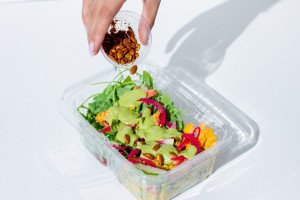The Grocery Shopping Glossary: What ‘Natural,’ ‘Low Sugar’ and 30 Other Confusing Food Labels Mean
Any person who’s set foot in a grocery store knows that shopping for nutritious food isn’t nearly as easy as it sounds. Many foods are disguised as healthy, wearing fat-free or low-cal labels, when in reality they’re just more of the processed junk you’re trying to avoid. Which brings us to the question: What the heck do all those confusing phrases and labels actually mean? We’ve created a handy glossary to help you decode the mysterious language of food labels. Spoiler alert: After reading it, you’ll realize some of your “healthy” foods are anything but.
Calorie-free (also no calorie, zero calorie, etc.): A product has less than five calories per serving.
Cholesterol-free (also zero cholesterol, no cholesterol): A product has less than two milligrams of cholesterol per serving.
Enriched: Nutrients are added to replace those lost in food processing.
Fat-free: There is less than half a gram of fat per serving. But be careful—oftentimes foods that are low in fat have added sugar.
Fortified: Extra vitamins or minerals have been added to the product that were lost in processing.
Gluten-free: A product with this label will not include any gluten-containing grains (wheat, rye or barley) or will not exceed the allowable gluten threshold of 20 parts per million.
GMO-free: GMO stands for “genetically modified organism,” or a food whose genes have been combined with genes from another species. This is a label you WANT to see on your food.
Healthy: FDA regulations say a food is healthy if it is low in fat and saturated fat, limited in sodium and cholesterol, and provides at least 10 percent of your daily value of one or more of these nutrients: vitamin A, vitamin C, calcium, iron, protein, or fiber; USDA has slightly different regulations for their products.
High fiber: The Whole Grains Council states that “high fiber” means a product has at least five grams of fiber per serving.
Lean: Found on your meat, poultry, and seafood packages, the term “lean” or “lean cut” means there is no more than 10 grams of fat (of which no more than four and a half grams is saturated fat, and less than 95 milligrams of cholesterol) in a 100 gram serving.
Light (or lite): A food has one third the calories and half the fat of the regular item (a food only has half the fat if more than 50 percent of the calories in the original are from fat, so keep that in mind).
Lightly salted: The lighter version of your favorite chips have 50 percent less sodium than what is added to the original product, while also meeting the “low sodium” standards.
Low calorie: A food has 40 calories or less per serving; if we’re talking in terms of frozen dinners or other meals, it must have 120 calories or less per 100 grams.
Low carb: While there is no official definition for what defines a low-carb food, for most people, 50 to 130 grams per day is considered a low-carb diet.
Low cholesterol: A product has 20 milligrams or less per serving size and two grams or less of saturated fat.
Low fat: A product has three grams or less of total fat per serving; for meals, no more than 30 percent of calories can come from fat.
Low saturated fat: A product has one gram or less of saturated fat, and no more than 15 percent of calories in a given serving can come from saturated fats.
Low sodium: A product has 140 milligrams or less of sodium per serving.
Natural: These days, most food that comes in a package has some sort of processing involved, meaning very little packaged food is truly from nature. Even though there’s little regulation and the FDA hasn’t mandated a specific definition, “it has not objected to the use of the term if the food does not contain added color, artificial flavors, or synthetic substances,” according to the FDA’s website. Note, however, that this doesn’t include added sugars and other “natural” additives, so check the nutrition label for the full list of ingredients.
No added sugars: No sugar or sugar-containing ingredient was added to the product. This doesn’t mean the food doesn’t have any sugar, just that none was added during processing.
No salt added: No additional salt was added to the product during processing. Just as the label “no added sugar” doesn’t mean the food is sugar-free, this label doesn’t mean the food is sodium-free; if there are more than five grams of sodium, the phrase “This is not sodium free” will appear on the packaging.
Organic: When you see this label on an agricultural product (eggs, meat, poultry, etc.), it means the animals used to make those products weren’t given antibiotics or growth hormones. Organic plant foods are those made without the use of chemical-laden pesticides or synthetic fertilizers. A government official must inspect and certify growers or farmers who makes this claim. The package label will include the USDA organic seal.
Reduced/less calorie: A product has at least 25 percent fewer calories than the regular item.
Reduced fat: A product has at least 25 percent less fat than the regular item.
Reduced saturated fat: A product has at least 25 percent less saturated fat than the regular item.
Reduced sodium: A product has at least 25 percent less sodium than the regular item.
Whole grain: A product that contains grains that have kept their outer covering, making the product richer in fiber, vitamins, and minerals. Be wary of terms like “multi-grain,” “seven-grain,” or “stone-ground.” Sure they sound healthy, but products that boast these phrases can also contain enriched or refined grains as well as whole grains.
Saturated fat-free: A product has less than half a gram of saturated fat and no more than half a gram of trans fat in one serving.
Sugar-free: A product has less than half a gram of sugar in one serving, which not only means there is very little sugar, but there are also no ingredients that contain sugar. Remember the catch: Something that is very low in sugar usually makes up for it, taste-wise, by being high in fat.
Unsalted: See “no salt added.”
Vegan: No animal products or byproducts were used.
Vegetarian: No animals were used, though their byproducts may be, so ingredients like milk and eggs get the okay. Note: This is the traditional form of vegetarianism; there are varying degrees of vegetarians with slightly different eating habits.
Very low sodium: A product has 35 milligrams or less of sodium per serving.
Like what you’re reading? Experience Be Well Philly live at Be Well Philly Boot Camp fitness fest on June 7th!



